
Butterflies (Rhopalocera) are insects that have large, often brightly coloured wings, and a conspicuous, fluttering flight. The group comprises the superfamilies Hedyloidea and Papilionoidea. The oldest butterfly fossils have been dated to the Paleocene, about 56 million years ago, though they may have originated earlier.

Lepidoptera is an order of insects that includes butterflies and moths. About 180,000 species of the Lepidoptera have been described, representing ten percent of the total described species of living organisms, and placed in 126 families and 46 superfamilies. It is one of the most widespread and widely recognizable insect orders in the world. The Lepidoptera show many variations of the basic body structure that have evolved to gain advantages in lifestyle and distribution. Recent estimates suggest the order may have more species than earlier thought, and is among the four most species-rich orders, along with the Hymenoptera, Diptera, and Coleoptera.

The monarch butterfly or simply monarch is a milkweed butterfly in the family Nymphalidae. Other common names, depending on region, include milkweed, common tiger, wanderer, and black-veined brown. It is amongst the most familiar of North American butterflies and an iconic pollinator, although it is not an especially effective pollinator of milkweeds. Its wings feature an easily recognizable black, orange, and white pattern, with a wingspan of 8.9–10.2 cm (3.5–4.0 in). A Müllerian mimic, the viceroy butterfly, is similar in color and pattern, but is markedly smaller and has an extra black stripe across each hindwing.

Vanessa atalanta, the red admiral or, previously, the red admirable, is a well-characterized, medium-sized butterfly with black wings, red bands, and white spots. It has a wingspan of about 2 inches (5 cm). It was first described by Carl Linnaeus in his 1758 10th edition of Systema Naturae. The red admiral is widely distributed across temperate regions of North Africa, the Americas, Europe, Asia, and the Caribbean. It resides in warmer areas, but migrates north in spring and sometimes again in autumn. Typically found in moist woodlands, the red admiral caterpillar's primary host plant is the stinging nettle ; it can also be found on the false nettle. The adult butterfly drinks from flowering plants like Buddleia and overripe fruit. Red admirals are territorial; females will only mate with males that hold territory. Males with superior flight abilities are more likely to successfully court females. It is known as an unusually calm butterfly, often allowing observation at a very close distance before flying away, also landing on and using humans as perches.

Asclepias is a genus of herbaceous, perennial, flowering plants known as milkweeds, named for their latex, a milky substance containing cardiac glycosides termed cardenolides, exuded where cells are damaged. Most species are toxic to humans and many other species, primarily due to the presence of cardenolides. However, as with many such plants, some species feed upon them or from them. The most notable of them is the monarch butterfly, which uses and requires certain milkweeds as host plants for their larvae.
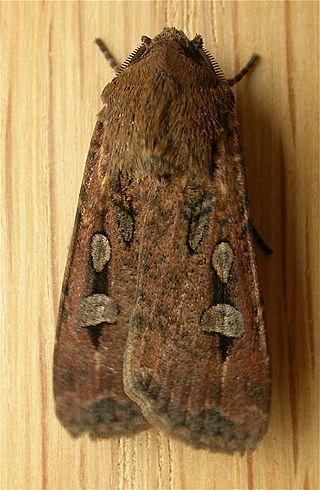
The bogong moth is a temperate species of night-flying moth, notable for its biannual long-distance seasonal migrations towards and from the Australian Alps, similar to the diurnal monarch butterfly. During the autumn and winter it is found in southern Queensland, western New South Wales, western Victoria, and also in South and Western Australia. Adult bogong moths breed and larvae hatch during this period, consuming winter pasture plants during their growth. During the spring, the moths migrate south or east and reside in mountains such as Mount Bogong, where they gregariously aestivate over the summer until their return towards breeding grounds again in the autumn.

Vanessa cardui is the most widespread of all butterfly species. It is commonly called the painted lady, or formerly in North America the cosmopolitan.

Asclepias syriaca, commonly called common milkweed, butterfly flower, silkweed, silky swallow-wort, and Virginia silkweed, is a species of flowering plant. It is native to southern Canada and much of the United States east of the Rocky Mountains, excluding the drier parts of the prairies. It is in the genus Asclepias, the milkweeds. It grows in sandy soils as well as other kinds of soils in sunny areas.

Tirumala limniace, the blue tiger, is a butterfly found in South Asia, and Southeast Asia that belongs to the brush-footed butterfly family, Nymphalidae. More specifically it is part of the crows and tigers or danaid group. This butterfly shows gregarious migratory behaviour in southern India. In some places, it may be found in congregations with Danaus genutia, Tirumala septentrionis, Euploea sylvester, Euploea core, Parantica aglea, and at high elevations, with Parantica nilgiriensis, on Crotalaria.
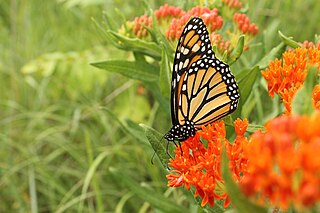
Butterfly gardening is a way to create, improve, and maintain habitat for lepidopterans including butterflies, skippers, and moths. Butterflies have four distinct life stages—egg, larva, chrysalis, and adult. In order to support and sustain butterfly populations, an ideal butterfly garden contains habitat for each life stage.

Insect migration is the seasonal movement of insects, particularly those by species of dragonflies, beetles, butterflies and moths. The distance can vary with species and in most cases, these movements involve large numbers of individuals. In some cases, the individuals that migrate in one direction may not return and the next generation may instead migrate in the opposite direction. This is a significant difference from bird migration.

Animal migration is the relatively long-distance movement of individual animals, usually on a seasonal basis. It is the most common form of migration in ecology. It is found in all major animal groups, including birds, mammals, fish, reptiles, amphibians, insects, and crustaceans. The cause of migration may be local climate, local availability of food, the season of the year or for mating.

Insect biodiversity accounts for a large proportion of all biodiversity on the planet—over half of the estimated 1.5 million organism species described are classified as insects.
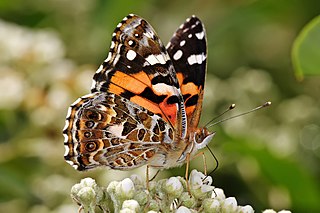
The Australian painted lady is a species of butterfly mostly confined to Australia, although westerly winds have dispersed it to islands east of Australia, including New Zealand. Debate surrounds the taxonomy of this species. Some believe that the Australian painted lady should be a subspecies of the painted lady due to the similarity in lifestyle and behaviour. Furthermore, the painted lady is found around the globe, but Australia is the only location in which it varies enough to be considered a separate species.

Episyrphus balteatus, sometimes called the marmalade hoverfly, is a relatively small hoverfly (9–12 mm) of the Syrphidae family, widespread throughout the Palaearctic region, which covers Europe, North Asia, and North Africa. It is considered the most abundant native hoverfly in Central Europe.
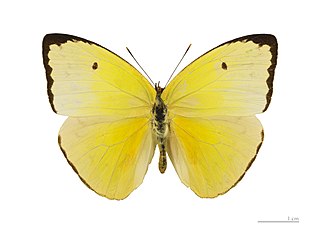
Aphrissa statira, the statira sulphur, is a species of Lepidoptera in the family Pieridae. The species is a medium-sized yellow butterfly, with females more pale than males. They are found from southern regions of Florida and Texas through southern Brazil and northern Argentina. The caterpillars feed on the leaves of several local host plants, while adults prefer to feed on the nectar of red or orange colored flowers. The species is most noted for their dramatic migrations in the tropical areas of the Americas. They have been the subject of many studies about how butterflies navigate and orient during migration.
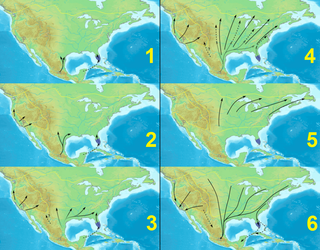
Monarch butterfly migration is the phenomenon, mainly across North America, where the subspecies Danaus plexippus plexippus migrates each summer and autumn to and from overwintering sites on the West Coast of California or mountainous sites in Central Mexico. Other subspecies perform minor migrations or none at all. This massive movement of butterflies has been called "one of the most spectacular natural phenomena in the world".

Altitudinal migration is a short-distance animal migration from lower altitudes to higher altitudes and back. Altitudinal migrants change their elevation with the seasons making this form of animal migration seasonal. Altitudinal migration can be most commonly observed in species inhabiting temperate or tropical ecosystems. This behavior is commonly seen among avian species but can also be observed within other vertebrates and some invertebrates. It is commonly thought to happen in response to climate and food availability changes as well as increasingly due to anthropogenic influence. These migrations can occur both during reproductive and non-reproductive seasons.

Migration, in ecology, is the large-scale movement of members of a species to a different environment. Migration is a natural behavior and component of the life cycle of many species of mobile organisms, not limited to animals, though animal migration is the best known type. Migration is often cyclical, frequently occurring on a seasonal basis, and in some cases on a daily basis. Species migrate to take advantage of more favorable conditions with respect to food availability, safety from predation, mating opportunity, or other environmental factors.




































